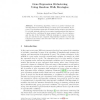Free Online Productivity Tools
i2Speak
i2Symbol
i2OCR
iTex2Img
iWeb2Print
iWeb2Shot
i2Type
iPdf2Split
iPdf2Merge
i2Bopomofo
i2Arabic
i2Style
i2Image
i2PDF
iLatex2Rtf
Sci2ools
DAWAK
2005
Springer
2005
Springer
Gene Expression Biclustering Using Random Walk Strategies
A biclustering algorithm, based on a greedy technique and enriched with a local search strategy to escape poor local minima, is proposed. The algorithm starts with an initial random solution and searches for a locally optimal solution by successive transformations that improve a gain function, combining the mean squared residue, the row variance, and the size of the bicluster. Different strategies to escape local minima are introduced and compared. Experimental results on yeast and lymphoma microarray data sets show that the method is able to find significant biclusters.
Related Content
| Added | 26 Jun 2010 |
| Updated | 26 Jun 2010 |
| Type | Conference |
| Year | 2005 |
| Where | DAWAK |
| Authors | Fabrizio Angiulli, Clara Pizzuti |
Comments (0)

